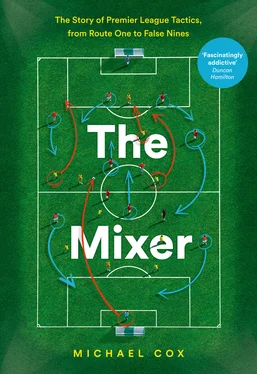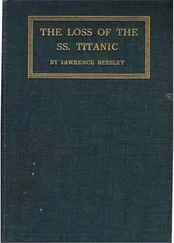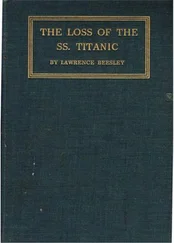Newcastle started the season, like Blackburn the previous year, with tactics based around crossing. Left-winger David Ginola was signed from Paris Saint-Germain and bamboozled opposition right-backs with his pace and ambidexterity, able to receive the ball with his back to goal, before spinning either way, cutting inside or going down the touchline. He won Player of the Month immediately. On the opposite flank Keith Gillespie was a typical winger of that period, always reaching the byline. Keegan’s instructions to his wingers were simple: new signing Les Ferdinand was the best target man in the business, and he was to be supplied with constant crosses. ‘The way the side was playing, with Ginola on the left and Gillespie on the right, was ideal for a striker like me,’ Ferdinand recalled. ‘Both David and Keith were raining balls into the penalty area from all over the place.’
Surprisingly for such an aerial threat, Ferdinand was only five foot 11, but was blessed with a prodigious leap. He hit 21 league goals by mid-February, while Keegan encouraged him to develop his game and bring teammates into play, having become frustrated with his predecessor Andy Cole’s single-mindedness. Whereas Blackburn used two target men up front, Keegan played Peter Beardsley in a deep-lying forward role, linking attacks. With Rob Lee bursting forward from central midfield, this was the most complete attacking force the Premier League had witnessed. Newcastle started at an incredible pace, attempting to win matches within the opening half hour, and weren’t involved in a single goalless draw all season. ‘The Entertainers’ tag, however, also underlined Newcastle’s defensive frailties. Keegan had openly preached a ‘you score two, we’ll score three’ philosophy, although the defining game in Newcastle’s season – and the most memorable in the Premier League era – was the defeat at Liverpool in April, which was ‘we’ll score three, you score four’. Many attributed Newcastle’s title failure to their leaky defence, although the truth is more complex.
Keegan made no attempt to hide his attacking approach. He was determined to satisfy the Geordies’ thirst for positive football, and considered himself part of a wider movement to make football more exciting, at a time when managers frequently highlighted the fact their team had ‘put on a show’ when matches were live on Sky. ‘A lot of forwards are coming into management,’ he said at the time. ‘You look at Brian Little, Glenn Hoddle, myself. We are all forwards who wouldn’t really know enough about defending to coach it.’ It was a selective argument, though. Arsenal boss George Graham had been a forward, then later an attacking midfielder so languid he was nicknamed ‘Stroller’, but he had assembled the most disciplined defence in English football.
Keegan’s defenders were, originally, midfielders and attackers. It’s common for players to be shifted into a different position as they develop, but Newcastle’s situation was quite remarkable, particularly with their three main centre-backs. Darren Peacock had been a centre-forward in the Bristol Rovers youth team. Steve Howey had risen through Newcastle’s ranks as an attacking midfielder, occasionally used in defence during training – but when Keegan arrived, he told Howey he was either a centre-back or he was leaving. Belgian Philippe Albert, meanwhile, started his career as a midfielder and was recruited on the strength of his displays at the 1994 World Cup, where he continually brought the ball forward from the back. Keegan, working as a TV pundit for the tournament, witnessed him score against both the Netherlands and Germany, and snapped him up.
First-choice full-backs Warren Barton and John Beresford were encouraged to push forward simultaneously and, by the end of the campaign, were replaced by hometown lads Steve Watson and Robbie Elliott, both forwards when rising through the ranks at Newcastle. Another Geordie, holding midfielder Lee Clark, had played an attacking midfield role the previous season, hence his number 10 shirt. It was, more or less, a team of forwards, as Keegan acknowledges in an admirably honest passage from his autobiography. ‘Were my full-backs too adventurous? Yes! Were my centre-backs too skilful, better going forward than going back? Yes! But that is what we built.’ That was that, and Keegan wasn’t going to change. Towards the end of the campaign, his back four – Watson, Howey, Peacock and Beresford – approached him, suggesting they were being overrun and Newcastle should play more cautiously. Keegan’s response to the critique was simple – ‘Do you wanna play on Saturday?’
He ignored defending to a remarkable extent. Newcastle had a rare defensive training session ahead of the long trip down to Southampton in September, lost 1–0, and Keegan never bothered with defensive drills again. Later, after Newcastle failed to win the Premier League, Keegan appointed former Liverpool defender and BBC pundit Mark Lawrenson as a defensive coach. Lawrenson, however, spent his time merely observing training and didn’t take a single coaching session under Keegan, at one point confessing to him that he wasn’t sure what he was being paid for. His appointment was Keegan’s attempt to fight the criticism rather than a genuine attempt to fix the problem.
But, amazingly, Newcastle’s defensive record in 1995/96 was actually reasonably good, and that famous 4–3 defeat at Anfield has exaggerated their weakness at the back. They conceded 37 goals in 38 matches, only two more than Manchester United, and considering the subsequent four title winners conceded 44, 33, 37 and 45 goals, Newcastle’s defensive record wasn’t a barrier to success. Instead, their problem was that they didn’t score enough, managing only 66 goals – lower than every single Premier League title winner. The ‘Entertainers’ tag wasn’t entirely true, and for all their individual brilliance, Newcastle lacked cohesion. It wasn’t simply that they ignored defensive work in training, more that they didn’t do any tactical work whatsoever. No work on shape, no work on build-up play, no work on set-pieces. Nothing that makes a group of players into a team.
Training was extremely simple, and the players loved it – as did the supporters. Newcastle used the facilities at Durham University, which meant training was essentially public and often watched by thousands of people during the title run-in. The players would arrive early and play head tennis, with Keegan and McDermott among the most feared doubles partnerships. They’d then play high-intensity, match-speed, small-sided games, the teams often determined by playground-style ‘pick teams’. They would end with skills and shooting drills, and some players would stay behind to work on individual technical aspects. But Newcastle never discussed team shape.
Keegan had a similarly relaxed attitude towards opponents. Alex Ferguson was increasingly adjusting small details to counter an opponent’s strengths and provided specific information on their weaknesses. But Keegan wouldn’t mention Newcastle’s upcoming opponents in training and would simply read out the opposition’s team sheet in the dressing room shortly before the warm-up. He’d add a couple of words to rubbish his opponents – ‘wouldn’t have any of them’, or, if he’d recently signed one of their players, ‘I’ve got the one I wanted.’ It was all about individuals. Ignoring the opposition proved particularly problematic in away matches, where Newcastle were literally only half as good as at St James’ Park – they won 52 points at home, just 26 away.
Keegan’s team talks rarely included specific instructions for coping with the opposition, although there was one notable exception. Ahead of a mid-April meeting with Aston Villa, Keegan realised Brian Little was using three centre-forwards – Dwight Yorke, Savo Milošević and Tommy Johnson – and therefore instructed left-back Beresford to defend narrower, helping Newcastle’s two central defenders. Beresford, however, complained that Keegan was ignoring the knock-on effect; Villa’s right-back, Gary Charles, would overlap into his left-back zone because Ginola wouldn’t track back. Keegan wasn’t interested. When the inevitable repeatedly happened – Charles found space on the right – Keegan shouted instructions to Beresford rather than Ginola. This infuriated Beresford, and the two had a blazing row by the St James’ Park touchline, which ended when Beresford told Keegan to ‘fuck off’, prompting his immediate substitution. ‘You can’t have players saying what he said to me,’ said Keegan afterwards. Beresford had started 32 of the 34 games until that point, but was dropped entirely for the final four games.
Читать дальше












